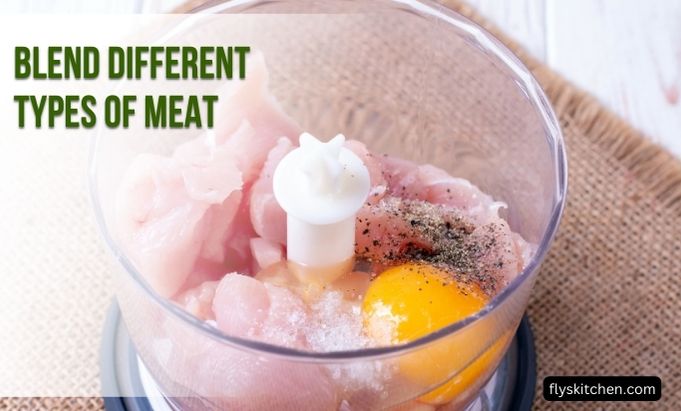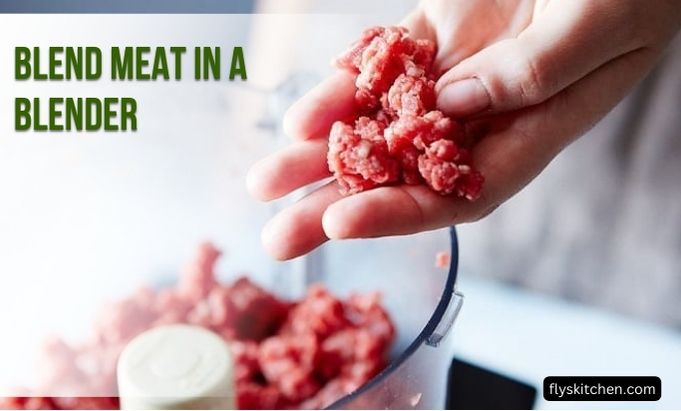Blending meat in a blender may seem like an unusual idea, but it can actually be a quick and easy way to finely chop, grate, or purée meat for certain recipes. With the right techniques and safety precautions, using a blender for meat can save you lots of time and effort in the kitchen.
Contents
Introduction
A blender is typically used for making smoothies, milkshakes, sauces, and other liquid mixtures. However, the fast-spinning blades in a blender are also capable of breaking down and processing solid foods like meat, nuts, and veggies.
Blending meat can be especially helpful for making minced meat, grinding meat for burgers or meatballs, making large batches of shredded meat for tacos or pasta dishes, or puréeing meat for baby food. It provides a fast alternative to tedious chopping, mincing, or grinding by hand.
However, raw meat can be risky to blend due to the potential for bacterial contamination. Proper food safety steps are essential. This article will cover everything you need to know about safely and effectively blending different types of meat in a blender.
Can All Types of Meat Be Blended?
Most types of raw or cooked meat, including beef, pork, chicken, turkey, lamb, and fish, can be successfully blended. The key is using the right techniques for each meat type.
Here is a breakdown of how well different meats blend:
- Beef: Blends very well raw or cooked. Choose tender cuts like sirloin or chuck roast.
- Chicken: Blends well raw or cooked if cubed or in small pieces. Remove bones first.
- Pork: Blends well raw or cooked. Chops, loin or shoulder meat works best.
- Fish: Blends well raw or cooked. Skin and bones must be removed first.
- Turkey: Blends well raw or cooked if chopped or ground first.
- Lamb: Blends well raw or cooked due to its soft texture.
The main factor that determines how easily meat will blend is tenderness. Tougher meats with more connective tissue and sinew, like beef brisket or lamb shoulder, can be challenging for a blender blade to break down.
For best results, choose tender cuts of meat and trim off any gristle, silver skin, or large chunks of fat before blending. Cut meat into 1-2 inch cubes to help it blend more smoothly.
Can You Blend Raw Meat in a Blender?
Yes, raw meat can be blended in a blender, however, extra precautions must be taken. Raw meat always carries bacteria that can cause foodborne illnesses.
When raw meat is blended, any pathogens on the surface get mixed throughout the entire batch. Then if it is not cooked to a safe internal temperature afterwards, those pathogens may survive.
To safely blend raw meat:
- Make sure meat is very fresh, kept cold, and used right away
- Cut meat into 1-2 inch pieces before blending
- Work in small batches of no more than 2 cups
- Keep blender carafe refrigerated before and after blending
- Do not fill blender more than 2/3 full
- Always cook blended meat mixture to 160°F afterwards
- Wash blender thoroughly after each use
Blending also has the advantage of evenly distributing salt and seasonings into ground meat. Just be sure to refrigerate it immediately since the increased surface area means it can spoil faster.
Meat Blending Safety Tips
Besides basic food safety with raw meat, blending meat does come with some additional risks and safety considerations:
- Don’t Overfill the Blender: Filling the blender carafe more than 2/3 full when blending meat increases the risk of hot motor damage and dangerous splatter. Add meat gradually while blending.
- Prevent Clogging: Don’t overprocess meat into a paste that can clog the blender blade and seize the motor. For ground meat, pulse in short bursts.
- Beware of Splatter: Use a blender splash guard and start on low speed to prevent raw meat from splattering all over your kitchen. Cover the opening with a towel.
- No Bones: Remove all bones, organs or connective tissues from meat before blending to prevent blade damage or motor strain.
- Clean Thoroughly: Residual fats and juices from meat can quickly build up inside a blender base and blades. Disassemble and wash thoroughly after each use.
Following basic safety precautions is key to avoiding issues when blending meat in your blender. Be mindful of the increased risk of bacterial contamination as well.
How to Blend Different Types of Meat?

The technique you use to blend meat depends on the desired consistency and recipe you are making. Here are some blending tips for common ground and blended meat preparations:
Ground Meat
For a fine, evenly ground texture similar to store bought ground meat, you want to pulse the blender rather than continuously blend.
- Cut meat into 1-2 inch cubes
- Working in batches, pulse 5-10 times until finely ground
- Be careful not to overprocess into a paste
- Transfer to an airtight container and refrigerate promptly
This works great for making your own fresh ground beef, turkey or other meats for burgers, meatballs, tacos, etc.
Minced Meat
For small bits of meat similar to hand minced meat, use an on/off pulsing method.
- Cut meat into 1-inch pieces
- Pulse in short 2-3 second bursts until minced to desired texture
- Do not over blend into a purée
- Chill minced meat immediately
Minced meat is perfect for pasta sauces, stews, chilis and more.
Meat Purée
For a perfectly smooth, pâté-like meat purée, you need to add some liquid to blend it into a spreadable consistency.
- Cut meat into 1-inch cubes
- Add 2-3 tablespoons of broth, milk or water per cup of meat
- Blend on high speed until completely smooth, 1-2 minutes
- Add seasonings like garlic and herbs and blend again briefly
Meat purées are great for baby food, dips, spreads and more.
Shredded Meat
To shred meat for tacos, sandwiches, casseroles and other uses, partially cook meat first before blending.
- Cook meat until just partially done, not fully cooked through
- Allow to cool slightly then cut into pieces
- Working in batches, pulse until shredded into strings or small crumbles
- Return shredded meat to pan to finish cooking if needed
Partially cooking makes the meat easier to shred than raw. Chicken, pork and beef work great.
Tips for Cleaning a Blender After Use With Meat
Thorough cleaning is imperative after blending meat to avoid cross contamination and build up of bacteria in crevices. Here are some blender cleaning tips:
- Rinse blender pitcher, lid and blade immediately after use before food dries on
- For dried on messes, fill pitcher with warm soapy water and blend on high for 30 seconds
- Remove stubborn fat and stains by blending ice cubes with dish soap
- Wash all parts in hot soapy water, use scrub brush on blender blades
- Consider washing blender parts in dishwasher on sanitize or hot water setting
- Allow all parts to air dry fully before reassembling blender
- Sanitize by occasionally blending a dilute bleach solution on high speed
Regularly disassembling and inspecting the blender gasket, base and blade assembly is also recommended. Replacing the blender gasket annually improves the seal and prevents leaks.
Best Blenders for Meat
Blending meat demands a durable, high-powered blender to break down dense tissues. These top-rated models can all handle meat blending tasks:
- Vitamix – Excellent for large batches and meat grinding with a 3+ HP motor
- Blendtec – Great for meat grinding and purées thanks to the blunt blade design
- Ninja Professional Blender – Budget model with a 1200 watt motor and stackable blades
- Breville Hemisphere Control – Variable speed settings for precision meat chopping
- Cuisinart Hurricane – Affordable blender with strong 1,500 watt motor
- KitchenAid 5-Speed Diamond – High performing blender from a trusted brand
Key features to look for are a motor over 1,000 watts, sharp stainless steel blades, and a 64-ounce or larger blending carafe. Avoid cheap blenders which can overheat or stall out trying to blend meat.
Common Meat Blending FAQs
Many people have additional questions about the process of blending various meats. Here are answers to some of the most frequently asked questions:
Can you make ground beef in a blender?
Yes, a blender can easily and quickly grind cut up beef into the texture of store bought ground beef for hamburgers, meatballs, etc. Pulse in short bursts rather than blending continuously.
Should meat be partially frozen before blending?
Partially freezing meat firms it up which can allow for more even grinding and blending results. It also helps keep the motor from overheating. Defrost just until meat is still very cold but can be cut into pieces.
Does cooked or raw meat blend better?
Raw meat has a softer, more pliable texture that blends a bit easier compared to fully cooked meat. But for shredded meat, partially cooked meat blends best. Fully cooked meat can be blended but may have a more shredded, stringy texture.
Can you blend fish, chicken, turkey or pork?
Both raw and cooked poultry, fish and pork can all be successfully blended with proper preparation. Be sure to remove any bones, skin and fatty parts first that could damage the blender.
Can meat be blended with other ingredients?
Yes, spices, marinades, vegetables and other ingredients can be added right into raw or cooked meat and blended together into burgers, meatballs, etc. Just be sure any added liquids don’t exceed the blender’s max fill line.
Conclusion
While unconventional, using a blender is an easy and efficient way to chop, grind or shred a variety of meats. With proper food safety for raw meat and care not to overfill or overprocess, most blenders can handle occasional meat prep tasks.
Investing in a heavy-duty blender with a powerful motor and sharp blades ensures the best results for your blended meat recipes. With the right techniques, cleaning and precautions, you can utilize your blender to simplify meal prep and expand your culinary options.

